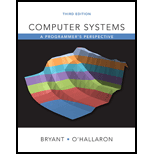
Explanation of Solution
Function definition for “float_i2f()” function:
The implementation for “float_i2f()”function is given below:
//Header file
#include <stdio.h>
#include <assert.h>
#include <limits.h>
//Declare the float_bits in unsigned data type
typedef unsigned float_bits;
//Function declaration for float_i2f function
float_bits float_i2f(int i);
//Function definition for compute the bit length
int findBitsLength(int i)
{
//Check bit length
if ((i & INT_MIN) != 0)
{
//Returns value "32"
return 32;
}
//Assign the unsigned number
unsigned unum = (unsigned)i;
//Initializes the length is "0"
int len = 0;
//Check the length
while (unum >= (1<<len))
{
len++;
}
//Returns the length
return len;
}
//Function definition to generate mask
unsigned findBitsMask(int bl)
{
//Returns the bits mask
return (unsigned) -1 >> (32-bl);
}
//Fnction definition for compute (float)i
float_bits float_i2f(int i)
{
//Declare variable
unsigned signBit, exponentBit, fractionBit, remainingBit, exp_signBit,rp;
//declare variable bits and float bits
unsigned b, fb;
//Assign bias value
unsigned biasValue = 0x7F;
//If "i" is "0", then
if (i == 0)
{
//Assign all bits to "0"
signBit = 0;
exponentBit = 0;
fractionBit = 0;
//Returns the value
return signBit << 31 | exponentBit << 23 | fractionBit;
}
//If "i" is "INT_MIN", then
if (i == INT_MIN)
{
//Assign given value to each bit
signBit = 1;
exponentBit = biasValue + 31;
fractionBit = 0;
//Returns the value
return signBit << 31 | exponentBit << 23 | fractionBit;
}
//Assign sign bit is "0"
signBit = 0;
/* For two's complement */
/* If "i" is less than "0", then */
if (i < 0)
{
//Assign sign bit to "1"
signBit = 1;
//Assign "i" to "i - i"
i = -i;
}
/* Compute bits length by calling function "findBitsLength" */
b = findBitsLength(i);
//Compute float bits
fb = b - 1;
//Compute exponent value
exponentBit = biasValue + fb;
//Compute remaining bit value
remainingBit = i & findBitsMask(fb);
//If "fb" is less than "23", then
if (fb <= 23)
{
//Assign fraction bit and except bit value
fractionBit = remainingBit << (23 - fb);
exp_signBit = exponentBit << 23 | fractionBit;
}
//Otherwise
else
{
//Compute offset value
int offsetValue = fb - 23;
//To find round middle value
int rm = 1 << (offsetValue - 1);
//For round part
rp = remainingBit & findBitsMask(offsetValue);
//Assign fraction bit and except bit value
fractionBit = remainingBit >> offsetValue;
exp_signBit = exponentBit << 23 | fractionBit;
/*Check if it is round to even */
if (rp < rm)
{
}
//If round to odd, then
else if (rp > rm)
{
...
Want to see the full answer?
Check out a sample textbook solution
Chapter 2 Solutions
Computer Systems: A Programmer's Perspective Plus Mastering Engineering With Pearson Etext -- Access Card Package (3rd Edition)
- Draw an ERD that will involve the entity types: Professor, Student, Department and Course. Be sure to add relationship types, key attributes, attributes and multiplicity on the ERD.arrow_forwardDraw an ERD that represents a book in a library system. Be sure to add relationship types, key attributes, attributes and multiplicity on the ERD.arrow_forward2:21 m Ο 21% AlmaNet WE ARE HIRING Experienced Freshers Salesforce Platform Developer APPLY NOW SEND YOUR CV: Email: hr.almanet@gmail.com Contact: +91 6264643660 Visit: www.almanet.in Locations: India, USA, UK, Vietnam (Remote & Hybrid Options Available)arrow_forward
- Provide a detailed explanation of the architecture on the diagramarrow_forwardhello please explain the architecture in the diagram below. thanks youarrow_forwardComplete the JavaScript function addPixels () to calculate the sum of pixelAmount and the given element's cssProperty value, and return the new "px" value. Ex: If helloElem's width is 150px, then calling addPixels (hello Elem, "width", 50) should return 150px + 50px = "200px". SHOW EXPECTED HTML JavaScript 1 function addPixels (element, cssProperty, pixelAmount) { 2 3 /* Your solution goes here *1 4 } 5 6 const helloElem = document.querySelector("# helloMessage"); 7 const newVal = addPixels (helloElem, "width", 50); 8 helloElem.style.setProperty("width", newVal); [arrow_forward
- Solve in MATLABarrow_forwardHello please look at the attached picture. I need an detailed explanation of the architecturearrow_forwardInformation Security Risk and Vulnerability Assessment 1- Which TCP/IP protocol is used to convert the IP address to the Mac address? Explain 2-What popular switch feature allows you to create communication boundaries between systems connected to the switch3- what types of vulnerability directly related to the programmer of the software?4- Who ensures the entity implements appropriate security controls to protect an asset? Please do not use AI and add refrencearrow_forward
 C++ for Engineers and ScientistsComputer ScienceISBN:9781133187844Author:Bronson, Gary J.Publisher:Course Technology Ptr
C++ for Engineers and ScientistsComputer ScienceISBN:9781133187844Author:Bronson, Gary J.Publisher:Course Technology Ptr C++ Programming: From Problem Analysis to Program...Computer ScienceISBN:9781337102087Author:D. S. MalikPublisher:Cengage LearningCOMPREHENSIVE MICROSOFT OFFICE 365 EXCEComputer ScienceISBN:9780357392676Author:FREUND, StevenPublisher:CENGAGE L
C++ Programming: From Problem Analysis to Program...Computer ScienceISBN:9781337102087Author:D. S. MalikPublisher:Cengage LearningCOMPREHENSIVE MICROSOFT OFFICE 365 EXCEComputer ScienceISBN:9780357392676Author:FREUND, StevenPublisher:CENGAGE L- Programming Logic & Design ComprehensiveComputer ScienceISBN:9781337669405Author:FARRELLPublisher:Cengage
 EBK JAVA PROGRAMMINGComputer ScienceISBN:9781337671385Author:FARRELLPublisher:CENGAGE LEARNING - CONSIGNMENT
EBK JAVA PROGRAMMINGComputer ScienceISBN:9781337671385Author:FARRELLPublisher:CENGAGE LEARNING - CONSIGNMENT Microsoft Visual C#Computer ScienceISBN:9781337102100Author:Joyce, Farrell.Publisher:Cengage Learning,
Microsoft Visual C#Computer ScienceISBN:9781337102100Author:Joyce, Farrell.Publisher:Cengage Learning,





